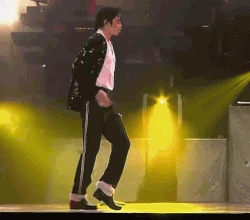
The Moonwalk (formerly the Backslide) is a dance technique that presents the illusion of the dancer being pulled backwards while attempting to walk forward. A popping move, it became more popular around the world after Michael Jackson executed the dance move during a performance of "Billie Jean" on Motown 25: Yesterday, Today, Forever on March 25th, 1983.
It subsequently became his signature move, and is now one of the best-known dance techniques in the world. An illusion is involved in creating the appearance of the dancer gliding. The leg being pulled up moves the leg behind it back (with the toes still touching the ground) and transfers the weight on to it. The leg with weight on it goes up and the other leg is drawn back in turn. These steps are repeated over and over. Variations of this move allow the backslider to also appear to glide forwards, sideways, and even in a circle.[1]
History[]
There are many recorded instances of the moonwalk, Similar steps are reported as far back as 1932, used by Cab Calloway. In 1985, Calloway said that the move was called "The Buzz" when he and others performed it.
The origin is the pantomime exercise "Marche sur place" created by mime masters Etienne Decroux and Jean-Louis Barrault and first recorded on film for Children of Paradise in 1944/45). In 1955 it was recorded in a performance by tap dancer Bill Bailey. He performs a tap routine, and at the end, backslides into the wings. The French mime artist, Marcel Marceau, used it throughout his career (from the 1940s through the 1980s), as part of the drama of his mime routines. In Marceau's famous "Walking Against the Wind" routine Marceau pretends to be pushed backwards by a gust of wind.
An embryonic version of the move appears in Bowie's 1960s mime pieces; he had studied mime under Étienne Decroux, Marcel Marceau's teacher, and under Lindsay Kemp, who had trained with Marceau. By the time of Bowie's 1974 Diamond Dogs Tour, Michael Jackson was among those attending Bowie's Los Angeles shows, later remarking on Bowie's strange moves.
Another early moonwalker was popper and singer Jeffrey Daniel, who moonwalked in a performance of Shalamar's "A Night To Remember" on Top of the Pops in the UK in 1982, and was known to perform backslides in public performances (including weekly Soul Trian episodes) well before this date. Also in 1982, Debbie Allen performs a moonwalk during a scene with Gwen Verdon in Season 1, Episode 10 ("Come One, Come All") of the 1982 TV series Fame. Jeffrey Daniel taught Michael Jackson the moonwalk. Jackson saw Daniel do the moonwalk dance on Soul Train and had his manager call Soul Train to introduce him to the dancer.
There is a similar dance to the moonwalk as well. It is known today as the 'airwalk.' A street dancer in Madrid. In the movie Flashdance, released in 1983, the move was used in the breakdance scene, where a street performer, with an umbrella prop, mimed the wind blowing him backward as he first walks forward, fighting the wind, then starts moonwalking backwards.[2]
During Michael Jackson's Performance at Motown 25[]
The dance was brought to further public attention on March 25th, 1983 (May 16th on NBC), when Michael Jackson performed it during the worldwide broadcast of the television special, Motown 25: Yesterday, Today, Forever. Dressed in his signature black trousers, silver socks, silver shirt, black-sequined jacket, single sequined glove, and black fedora, Jackson spun around, posed, and began moonwalking backwards (normal direction). Ian Inglis writes that Jackson encapsulated a long tradition of African American dance movements in that one performance. The audience cheered Michael's moonwalk, and he received a standing ovation (watch the entire remastered performance of Billie Jean here[3]). Later that same night, Michael received a phone call from renowned dancer and movie star Fred Astaire, who congratulated him on his performance.
Moonwalking received widespread attention, and from then on, the moonwalk became Jackson's signature move for his song "Billie Jean". Nelson George said that Jackson's rendition "combined Jackie Wilson's athleticism with James Brown's camel walk." Michael Jackson's autobiography was titled Moonwalk, and he also starred in a 1988 film titled Moonwalker.[4]
After Michael Jackson's Performance at Motown 25[]
The period encompassing the release of Thriller in November of 1982, the release of Billie Jean's music video on MTV in March of 1983, and Motown 25's broadcast in March/May of 1983 represented a seismic cultural shift in the pop culture of America (and eventually, the world). For the first time in the modern era, kids and adults across the cultural and racial spectrum wanted to emulate an African American artist — and wanted to purchase his music. Michael's performance not only solidified him as one of the great entertainers; it helped him break racial barriers and set the bar for a new generation of artists and performers. To this day, the Moonwalk remains one of the most recognizable dances in the history of humanity.
This dance has affected many people after its appearance in Motown 25 by Michael Jackson. Alexei Kovalev has also been known for using the moonwalk in his NHL career. He performed the move after scoring a goal on February 7, 2001.[5] Michael Jackson did this move in other concerts and performances and has actually made some better moonwalks later on.[6] Alexei Kovalev moonwalked on to the ice after being named one of the stars of the game and again after scoring on a penalty kick in a 2008 celebrity charity soccer game. Alexei Kovalev has also used the moonwalk again on January 3, 2010 in his NHL career.[7]
Videos[]
References[]
- ↑ http://en.wikipedia.org/wiki/Moonwalk_%28dance%29
- ↑ http://en.wikipedia.org/wiki/Moonwalk_%28dance%29
- ↑ https://youtu.be/xpN3GRFKb4w
- ↑ http://en.wikipedia.org/wiki/Moonwalk_%28dance%29
- ↑ http://en.wikipedia.org/wiki/Moonwalk_%28dance%29
- ↑ http://www.youtube.com/watch?v=s7MmEMrCRfc
- ↑ http://en.wikipedia.org/wiki/Moonwalk_%28dance%29



